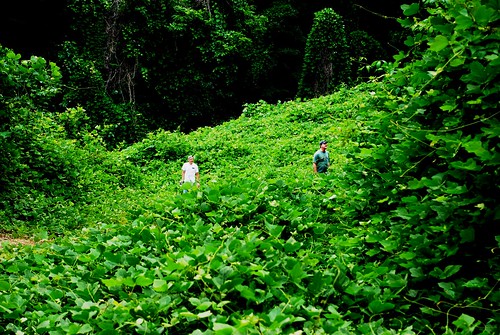Kudzu will grow over anything in its path. (Photo by jjjj56cp)
In traditional Chinese Medicine, kudzu – a quick-growing vine native to China and Japan – is commonly used to treat alcoholism and hangover. This may be due to its potential to increase blood levels of alcohol when taken with an alcoholic beverage. Indeed, at least one study found that giving kudzu to heavy drinkers resulted in lower alcohol consumption (link).
The name kudzu encompasses at least five different species of the plant genus Pueraria. While all of them have very similar properties and are can be used for their medicinal purposes, the most often mentioned species are Pueraria lobata and Pueraria thomsonii. The various species contain a significant amount of isoflavones, which may at least partly be behind their use as a treatment for alcoholism.
Isoflavones, however, also have other uses. Because of their slight estrogenic effect, isoflavones from sources such as soy have been studied as a cure for hair loss. The idea is that isoflavones can inhibit 5-alpha-reductase, which converts testosterone into DHT. Since DHT binds to androgen receptors more potently than testosterone, DHT is a major cause of hair loss in genetically predisposed individuals.
Although the root part of the plant is often used, a recent study showed that the flowers of Pueraria thomsonii were much more effective in inhibiting 5-alpha-reductase than the roots of Pueraria lobata (~51% vs. ~7%). The flowers were powdered and made into a 50% ethanol extract, which was then applied onto the backs of mice after a testosterone treatment (link).
Applying the flower extract improved hair growth in a dose-dependent manner. The mice that got the largest dose (5 mg/day) after testosterone had a hair growth score similar to the control mice that were not treated with testosterone. In other words, the kudzu treatment reversed almost all of the hair loss effects of testosterone.
The authors also applied the extract on C3H/He mice without the testosterone to see whether it would promote hair growth independently of an anti-androgenic effect. The higher dose was almost as effective as minoxidil in promoting hair growth. Although the mechanism was not clear, the authors note that the flowers have been shown to have an angiogenetic effect.
Like soy, kudzu contains significant amounts of the isoflavone daidzein, daidzin and genistein. However, kudzu also contains an isoflavone called puerarin, which is not found in soy. Furthermore, Pueraria thomsonii flowers contain both soyasapones (one of the main components of soy beans) and kaikasaponins (not found in soy), making it rather unique.
I've seen a couple of soaps and shampoos that list kudzu as an ingredient, but I doubt that the amounts are large enough to truly make a difference. If you want to try kudzu topically, you might have better luck buying an extract in powder form and making your own topical. Another possibility is simply taking it orally. There is, after all, evidence that dietary isoflavones promote hair growth.
For more information on hair growth, see these posts:
Biotin Goes Back on the Menu
Soy Isoflavones and Chili Pepper for Hair Growth – Experiment Update
Topical Retinoids Increase Hair Growth in Most People
Zinc Pyrithione Reduces Shedding and Moderately Promotes Hair Growth











